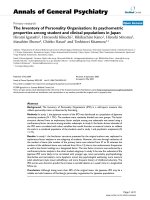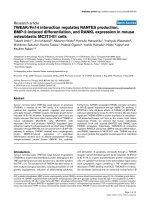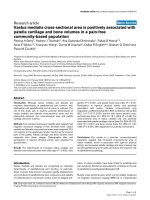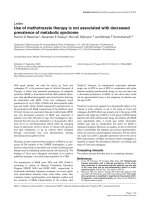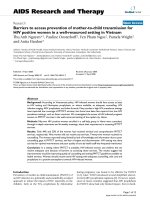Báo cáo y học: "Vastus medialis cross-sectional area is positively associated with patella cartilage and bone volumes in a pain-free community-based population" ppt
Bạn đang xem bản rút gọn của tài liệu. Xem và tải ngay bản đầy đủ của tài liệu tại đây (110.52 KB, 6 trang )
Open Access
Available online />Page 1 of 6
(page number not for citation purposes)
Vol 10 No 6
Research article
Vastus medialis cross-sectional area is positively associated with
patella cartilage and bone volumes in a pain-free
community-based population
Patricia A Berry
1
, Andrew J Teichtahl
1
, Ana Galevska-Dimitrovska
1
, Fahad S Hanna
1,2
,
Anita E Wluka
1,2
, Yuanyuan Wang
1
, Donna M Urquhart
1
, Dallas R English
3,4
, Graham G Giles
3
and
Flavia M Cicuttini
1
1
Department of Epidemiology and Preventive Medicine, Monash University Central and Eastern Clinical School, Commercial Road, Melbourne, 3004,
Australia
2
Baker Heart Research Institute, Commercial Road, Melbourne, 3004, Australia
3
Cancer Epidemiology Centre, The Cancer Council of Victoria, Rathdowne Street, Melbourne, 3053, Australia
4
School of Population Health, The University of Melbourne, Bouverie Street, Melbourne, 3010, Australia
Corresponding author: Flavia M Cicuttini,
Received: 1 Aug 2008 Revisions requested: 29 Sep 2008 Revisions received: 20 Nov 2008 Accepted: 15 Dec 2008 Published: 15 Dec 2008
Arthritis Research & Therapy 2008, 10:R143 (doi:10.1186/ar2573)
This article is online at: />© 2008 Berry et al.; licensee BioMed Central Ltd.
This is an open access article distributed under the terms of the Creative Commons Attribution License ( />),
which permits unrestricted use, distribution, and reproduction in any medium, provided the original work is properly cited.
Abstract
Introduction Although vastus medialis and lateralis are
important determinants of patellofemoral joint function, their
relationship with patellofemoral joint structure is unknown. The
aim of this study was to examine potential determinants of
vastus medialis and lateralis cross-sectional areas and the
relationship between the cross-sectional area and patella
cartilage and bone volumes.
Methods Two hundred ninety-seven healthy adult subjects had
magnetic resonance imaging of their dominant knee. Vastus
medialis and lateralis cross-sectional areas were measured 37.5
mm superior to the quadriceps tendon insertion at the proximal
pole of the patella. Patella cartilage and bone volumes were
measured from these images. Demographic data and
participation in vigorous physical activity were assessed by
questionnaire.
Results The determinants of increased vastus medialis and
lateralis cross-sectional areas were older age (P ≤ 0.002), male
gender (P < 0.001), and greater body mass index (P ≤ 0.07).
Participation in vigorous physical activity was positively
associated with vastus medialis cross-sectional area
(regression coefficient [beta] 90.0; 95% confidence interval [CI]
38.2, 141.7) (P < 0.001) but not with vastus lateralis cross-
sectional area (beta 10.1; 95% CI -18.1, 38.3) (P = 0.48). The
cross-sectional area of vastus medialis only was positively
associated with patella cartilage volume (beta 0.6; 95% CI 0.23,
0.94) (P = 0.001) and bone volume (beta 3.0; 95% CI 1.40,
4.68) (P < 0.001) after adjustment for potential confounders.
Conclusions Our results in a pain-free community-based
population suggest that increased cross-sectional area of
vastus medialis, which is associated with vigorous physical
activity, and increased patella cartilage and bone volumes may
benefit patellofemoral joint health and reduce the long-term risk
of patellofemoral pathology.
Introduction
Vastus medialis and lateralis are recognised as important
determinants of patellofemoral joint function. In particular,
these muscles help prevent excessive patella displacement
and contribute to patellofemoral joint congruency and stability
[1]. Deficiencies in neuromotor control, such as delayed acti-
vation of vastus medialis, have been linked to patellofemoral
pain syndrome [2] and are speculated to contribute to the risk
of patellofemoral subluxation/dislocation [3].
Muscle cross-sectional area, which can be reliably measured
via magnetic resonance imaging (MRI) [4] or computerised
BMI: body mass index; CI: confidence interval; MCCS: Melbourne Collaborative Cohort Study; MR: magnetic resonance; MRI: magnetic resonance
imaging; PCSA: physiological cross-sectional area.
Arthritis Research & Therapy Vol 10 No 6 Berry et al.
Page 2 of 6
(page number not for citation purposes)
tomography [5], is representative of the force-producing capa-
bility of a muscle [6]. Previous studies have examined the
cross-sectional area of the quadriceps and have used the mid-
thigh level to assess the maximum force-producing capability
of the quadriceps muscle group [5,7,8]. Studies examining
spinal pathology have demonstrated that reduced cross-sec-
tional area of local muscles that are in close proximity to the
joint, attaching directly to the lumbar spine, are associated
with low back pain, whereas increased cross-sectional area of
these muscles contributes to spinal control [9-11]. However,
it is unclear whether an increased cross-sectional area of local
muscles at other anatomical sites confers similar benefits.
Although distal vastus medialis and lateralis muscles have
been implicated in patellofemoral pain [2] and subluxation/dis-
location [3], their association with patellofemoral joint struc-
tures is unclear. Similarly, the determinants of vastus medialis
and lateralis cross-sectional areas are unclear.
In a community-based population of women, we recently
showed that increased vastus medialis cross-sectional area
was positively associated with patella bone volume, but not
patella cartilage volume [12]. Whether this relationship is sim-
ilar in males is unknown. Moreover, whether the lack of a rela-
tionship with cartilage was a true effect or was due to
inadequate power of that study is unknown. Thus, the aim of
this study was to examine the determinants of vastus medialis
and lateralis cross-sectional areas and whether vastus media-
lis cross-sectional area is associated with patella cartilage vol-
ume. In addition, we aimed to determine whether these
findings are similar in males and females.
Materials and methods
Subjects
Subjects were recruited from an existing cohort – the Mel-
bourne Collaborative Cohort Study (MCCS), a prospective
cohort study of community-based people 40 to 69 years old at
recruitment (1990 to 1994) – with the aim of examining the
role of lifestyle and genetic factors in the risk of cancer and
chronic diseases from middle age and beyond, as previously
described [13]. Individuals were excluded if in the last 5 years
they had knee pain lasting for more than 24 hours, a previous
knee injury requiring non-weight-bearing treatment for more
than 24 hours or surgery (including arthroscopy), or a history
of any arthritis diagnosed by a medical practitioner. A further
exclusion criterion was a contraindication to MRI. The study
was approved by The Cancer Council Victoria's Human
Research Ethics Committee and the Standing Committee on
Ethics in Research Involving Humans of Monash University
(Melbourne, Australia). All participants gave written informed
consent.
Data collection
Height and weight were measured and body mass index (BMI)
was calculated. At MCCS recruitment from 1990 to 1994,
subjects completed a questionnaire that collected demo-
graphic and physical activity information. Subjects were
asked, 'On average (over the last 6 months), how many times
a week did you exercise vigorously for a period of 20 minutes?'
Frequency of weekly episodes of vigorous physical activity
was categorised into three groups: never, once or twice per
week, and at least three times per week. Subjects were cate-
gorised as participating in vigorous physical activity if they
exercised once or twice per week or at least three times per
week. Vigorous was defined as activity leading to sweating or
dyspnoea, and examples such as swimming, tennis, netball,
athletics (which may involve running, walking, throwing or
jumping), and running were listed.
Magnetic resonance imaging
MRI was performed on the dominant knee as previously
described [14]. The following sequence and parameters were
used: a T1-weighted fat-suppressed three-dimensional gradi-
ent recall acquisition in the steady state; flip angle 55 degrees;
repetition time 58 milliseconds; echo time 12 milliseconds;
field of view 16 cm; 60 partitions; 512 (frequency direction,
superior-inferior) × 512 (phase-encoding direction, anterior-
posterior) matrix; one acquisition, time 11 minutes 56 sec-
onds. Sagittal images were obtained at a partition thickness of
1.5 mm and an in-plane resolution of 0.31 mm × 0.31 mm
(512 × 512 pixels). The sagittal MR images were reformatted
in the axial plane with a partition thickness of 1.25 mm and an
in-plane resolution of 0.31 × 0.31 mm (512 × 512 pixels).
Vastus medialis and lateralis cross-sectional areas
Distal vastus medialis and lateralis cross-sectional areas were
measured directly from axial images by one trained observer
manually drawing disarticulation contours around the muscle
boundaries using the independent workstation software Osiris
(Digital Imaging Unit, University Hospital of Geneva, Geneva,
Switzerland). The cross-sectional area was measured at the
MR slice 37.5 mm superior to the quadriceps tendon insertion
at the proximal pole of the patella, orthogonal to the long axis
of the leg. This slice was chosen as it was the largest slice vis-
ible across all subjects. The intraobserver reliability for vastus
muscle cross-sectional area (expressed as intraclass correla-
tion coefficient) was 0.99.
Measurement of patella cartilage and bone volumes
Patella cartilage and bone volumes were determined by man-
ually drawing disarticulation contours around the patella
boundaries on images 1.5 mm apart on sagittal views, using
image processing on an independent workstation using the
Osiris software as previously described [14,15]. The coeffi-
cients of variation were 2.1% for patella cartilage volume and
2.2% for patella bone volume [16].
Statistical analyses
Outcome variables, including distal vastus medialis and later-
alis cross-sectional areas and cartilage and bone volumes,
were initially assessed for normality and were found to approx-
Available online />Page 3 of 6
(page number not for citation purposes)
imate the normal distribution. Univariable and multiple linear
regression models were used to examine determinants of vas-
tus medialis and lateralis cross-sectional areas and the rela-
tionship with patella cartilage and bone volumes. Potential
confounders, including age, gender, BMI, and participation in
vigorous physical activity, were adjusted for in multivariate
analyses. R
2
values were calculated to determine the propor-
tion of variance explained by the multiple regression equation.
All analyses were performed using the SPSS statistical pack-
age (standard version 14.0; SPSS Inc., Chicago, IL, USA). A
P value of less than 0.05 was considered statistically signifi-
cant.
Results
The characteristics of the 297 subjects (63% women) who
participated in the study are presented in Table 1.
Determinants of distal vastus medialis and lateralis
muscle cross-sectional areas
The determinants of vastus medialis and lateralis cross-sec-
tional areas are presented in Table 2. After adjustment for
potential confounders, including gender, BMI, and participa-
tion in vigorous physical activity, we found that age was nega-
tively associated with vastus medialis and with vastus lateralis
cross-sectional area. Women had significantly smaller vastus
medialis and vastus lateralis cross-sectional area than men in
multivariate analysis. BMI was positively associated with vas-
tus medialis cross-sectional area in multivariate analysis, with
a similar trend observed with vastus lateralis. Participation in
vigorous physical activity (binary variable) was positively asso-
ciated with vastus medialis cross-sectional area in multivariate
analysis, whereas no significant association was seen for vas-
tus lateralis. In multivariate analysis, similar results were
obtained when the relationship between increasing frequency
of weekly episodes of vigorous physical activity and vastus
medialis (beta 54.9; 95% confidence interval [CI] 24.6, 85.2)
(P = 0.0004) and vastus lateralis (beta 3.0; 95% CI -13.6,
19.5) (P = 0.73) was considered.
Relationship between distal vastus medialis and
lateralis cross-sectional areas and patella structures
The association between vastus medialis and lateralis cross-
sectional areas and patella structures, including cartilage and
bone volumes, is presented in Table 3. Vastus medialis, but
not vastus lateralis, cross-sectional area was positively associ-
ated with patella cartilage volume and bone volume in multivar-
iate analysis. To determine whether gender differences in
effect exist, men and women were analysed separately in mul-
tivariate analyses. The relationship between vastus medialis
cross-sectional area and patella cartilage volume was similar
for men (beta 0.68; 95% CI -0.01, 1.38) (P = 0.054) and
women (beta 0.38; 95% CI -0.02, 0.77) (P = 0.06), and the
relationship between vastus medialis cross-sectional area and
patella bone volume was also similar for men (beta 3.79; 95%
CI 0.95, 6.63) (P = 0.01) and women (beta 2.16; 95% CI
0.07, 4.24) (P = 0.04). Similar results were obtained when
height and weight were used in the multivariate regression
equation instead of BMI (data not shown).
Discussion
Our results have demonstrated that older age, female gender,
and lower BMI are associated with reduced vastus medialis
and lateralis cross-sectional areas. Participation in vigorous
physical activity was associated with increased vastus media-
lis, but not vastus lateralis, cross-sectional area. Similarly, only
increased vastus medialis cross-sectional area was associ-
ated with increased patella cartilage and bone volumes. These
findings suggest that increased vastus medialis cross-sec-
tional area may benefit patellofemoral joint health.
Our measure of vastus medialis and lateralis cross-sectional
areas demonstrated expected relationships, with age and
female gender being associated with a reduction in vastus
Table 1
Characteristics of the study population (n = 297)
Mean (SD)
a
Age at magnetic resonance imaging, years 59.1 (6.3)
Females, number (percentage) 186 (63)
Body mass index, kg/m
2
25.2 (3.8)
Participation in vigorous physical activity, number of subjects (percentage)
b
107 (36)
Distal vastus medialis cross-sectional area, mm
2
1,171 (306)
Distal vastus lateralis cross-sectional area, mm
2
333 (127)
Patella cartilage volume, mm
3
2,656 (886)
Patella bone volume, mm
3
20,276 (4,667)
a
Values are reported as mean (standard deviation, SD) unless otherwise stated.
b
Participation in vigorous physical activity at least once or twice a
week or at least three times per week (over the last 6 months) for a period of 20 minutes that leads to sweating or dyspnoea.
Arthritis Research & Therapy Vol 10 No 6 Berry et al.
Page 4 of 6
(page number not for citation purposes)
medialis and lateralis cross-sectional areas, whereas BMI was
associated with greater vastus medialis and lateralis cross-
sectional areas. Though not examined specifically in this study,
a reduction in muscle size has been shown to be common with
aging [4,17,18], and it has been shown that females have, on
average, less muscle mass relative to males [17,19]. In con-
trast, a larger BMI may be inherently associated with increased
muscle cross-sectional area due to a larger body size. We
have also demonstrated that participation in vigorous physical
activity was associated with increased vastus medialis, but not
vastus lateralis, cross-sectional area. A primary action of the
distal portion of vastus medialis is to dynamically restrain the
natural tendency of the patella to track laterally [1]. Therefore,
the relationship between vastus medialis cross-sectional area
and participation in physical activity may, in the setting of vig-
orous physical activity, reflect vastus medialis hypertrophy in
an attempt to restrain excessive lateral patella displacement.
We have previously examined the relationship between vastus
medialis and lateralis cross-sectional areas and patella struc-
tures [12] in an independent and smaller (n = 175) cohort of
healthy women (mean age of 52 years). In this previous study,
we demonstrated a positive association between vastus medi-
alis cross-sectional area and patella bone volume, but not car-
tilage volume. In the present study, we examined an entirely
independent cohort and substantiated all previously signifi-
cant findings while also noting that increased patella cartilage
volume is significantly associated with an increased cross-
sectional area of vastus medialis. The discrepancy in cartilage
volume results between the two independent studies may be
attributable to the smaller sample size of our previous study.
Moreover, in the present study, we included males and thus
expanded the generalisability of our findings. Subsequently,
the present study substantiates previous findings pertaining to
both men and women. In the past and present studies, we
Table 2
Determinants of distal vastus medialis and vastus lateralis cross-sectional areas
Univariate regression coefficient
(95% CI)
Multivariate regression coefficient
(95% CI)
a
R
2
for model
a
Vastus medialis cross-sectional area, mm
2
Age, years -1.39 (-7.78, 4.99) -7.1 (-11.7, -2.6)
b
0.532
Gender -415.9 (-470.2, -361.5)
b
-391.6 (-443.0, -340.2)
b
0.532
Body mass index, kg/m
2
27.5 (18.9, 36.2)
b
21.7 (15.2, 28.2)
b
0.532
Participation in vigorous physical activity,
yes/no
118.6 (47.0, 190.1)
b
90.0 (38.2, 141.7)
b
0.532
Vastus lateralis cross-sectional area, mm
2
Age, years -1.7 (-4.4, 0.94) -3.3 (-5.8, -0.8)
b
0.192
Gender -105.6 (-133.0, -78.2)
b
-106.0 (-134.0, -78.0)
b
0.192
Body mass index, kg/m
2
4.8 (1.1, 8.6)
c
3.3 (-0.2, 6.8) 0.192
Participation in vigorous physical activity,
yes/no
23.2 (-6.8, 53.3) 10.1 (-18.1, 38.3) 0.192
a
Age, gender, body mass index, and participation in vigorous physical activity included in multivariate regression equation.
b
P < 0.01.
c
P < 0.05.
CI, confidence interval.
Table 3
Relationship between distal vastus medialis and vastus lateralis cross-sectional areas and patella structures
Univariate regression coefficient (95% CI) Multivariate regression coefficient (95% CI) R
2
for model
Vastus medialis cross-sectional area, mm
2
Patella cartilage volume, mm
3
1.5 (1.3, 1.8)
a
0.58 (0.23, 0.94)
a
0.472
b
Patella bone volume, mm
3
9.09 (7.69, 10.50)
a
3.04 (1.40, 4.68)
a
0.592
c
Vastus lateralis cross-sectional area, mm
2
Patella cartilage volume, mm
3
1.67 (0.89, 2.44)
a
-0.33 (-0.99, 0.33) 0.455
b
Patella bone volume, mm
3
10.3 (6.19, 14.31)
a
-1.31 (-4.40, 1.78) 0.574
c
a
P < 0.01.
b
Age, gender, body mass index, and participation in vigorous physical activity and patella cartilage volume included in the multivariate
regression equation.
c
Age, gender, body mass index, and participation in vigorous physical activity and patella bone volume included in the
multivariate regression equation. CI, confidence interval.
Available online />Page 5 of 6
(page number not for citation purposes)
have found vastus medialis, rather than vastus lateralis, to be
the significant determinant of patella structures. The relative
importance of vastus medialis at the patellofemoral joint is also
supported by electromyography studies, which demonstrated
that delayed activation of vastus medialis relative to vastus lat-
eralis is associated with patellofemoral pathologies, including
pain [2] and subluxation/dislocation [3].
How a greater vastus medialis cross-sectional area mediates
increased patella cartilage and bone volumes is unclear. Pre-
vious studies have shown that reduced cross-sectional areas
of local spinal muscles are associated with instability and low
back pain [9-11]. As indicated by extrapolating such data to
the patellofemoral joint, it may be that a greater cross-sectional
area of the vastus medialis muscle helps to prevent the natural
tendency of the patella to track laterally [1] and thus reduce
any shearing damage that may occur to articular surfaces.
This, in turn, may produce an optimal biomechanical environ-
ment and have a beneficial effect on patella structures, includ-
ing cartilage and bone. Moreover, our recent longitudinal data
have suggested that increased patella bone volume may be
advantageous to patellofemoral joint health, as increased
baseline bone volume was associated with a reduction in the
rate of patella cartilage volume loss [20]. Therefore, it may be
that increased vastus medialis cross-sectional area benefits
the patellofemoral joint via biomechanical effects on both
patella bone and cartilage volumes. Longitudinal studies are
required to determine whether increased vastus medialis
cross-sectional area reduces the risk of long-term patellofem-
oral pathology.
We examined a healthy population without knee pain or
pathology and our results cannot be generalised to sympto-
matic populations or those with established knee pathology.
Nevertheless, studying a healthy population allows the identi-
fication of factors that may be associated with early structural
changes at the knee and reduces the confounding effect of
reduction in muscle size due to pain-related disuse. Further-
more, this study may have been limited by our method for
assessing the cross-sectional area of the distal vastus medialis
and lateralis muscles. We measured the vastus muscles at the
MR slice 37.5 mm superior to the quadriceps tendon insertion
at the proximal pole of the patella. This slice was chosen as it
was the largest slice visible across all subjects. Moreover, we
have calculated cross-sectional area rather than the physiolog-
ical cross-sectional area (PCSA) that previously has been
employed to investigate muscle-force relationships [21]. Cal-
culating the PCSA requires imaging of the entire length of the
muscle fibre, which would be a costly and timely exercise
using MRI. However, our measure of cross-sectional area
showed the expected relationships with age, gender, and BMI.
It may be hypothesised that people with larger muscles inher-
ently have larger joint structures, including cartilage and bone
volumes, but if this were the case, vastus lateralis would have
been significantly associated with patella cartilage and bone.
Moreover, the relationships observed in this study were inde-
pendent of BMI, height, and weight (data not shown) as a
measure of body size. Although the determinants of patella
structure remain unclear, there is likely to be a complex inter-
play between the surrounding soft tissue support (for example,
vastus medialis and lateralis muscles) and the bony geometry
(for example, femoral sulcus angle and patella tilt). Therefore,
future studies may benefit from examining other articular sup-
ports that may also contribute to patellofemoral joint structure
and function.
Conclusion
Our results in a pain-free population without clinical knee oste-
oarthritis suggest that increased cross-sectional area of vas-
tus medialis, which is associated with participation in vigorous
physical activity, and increased patella cartilage and bone vol-
umes, may benefit patellofemoral joint health. This warrants
further investigation as a potential method for reducing long-
term patellofemoral pathology.
Competing interests
The authors declare that they have no competing interests.
Authors' contributions
FMC and AEW participated in the design of the study and in
the analysis and interpretation of data and reviewed the man-
uscript. DRE and GGG participated in the acquisition of data
and in the analysis and interpretation of data and reviewed the
manuscript. FSH participated in carrying out the measurement
of muscle structure and in the analysis and interpretation of
data and reviewed the manuscript. AG-D participated in carry-
ing out the measurement of muscle structure. YW carried out
the measurement of knee cartilage and bone structure, partic-
ipated in the analysis and interpretation of data, and reviewed
the manuscript. PAB and AJT performed the statistical analysis
and interpretation of data and drafted the manuscript. DMU
participated in the analysis and interpretation of data and
reviewed the manuscript. All authors read and approved the
final manuscript.
Acknowledgements
The Melbourne Collaborative Cohort Study recruitment was funded by
VicHealth and The Cancer Council of Victoria. This study was funded by
a program grant from the National Health and Medical Research Council
(NHMRC) (209057) and was further supported by infrastructure pro-
vided by The Cancer Council of Victoria. We would like to acknowledge
the NHMRC (project grant 334150) and the Colonial Foundation. AEW,
YW, and DMU are the recipients of NHMRC Public Health Fellowships
(317840, 465142, and 284402, respectively). PAB is the recipient of
an Australian Post-graduate Award PhD Scholarship. We would espe-
cially like to thank the study participants, who made this study possible.
References
1. Elias DA, White LM: Imaging of patellofemoral disorders. Clin
Radiol 2004, 59:543-557.
2. Cowan SM, Bennell KL, Hodges PW, Crossley KM, McConnell J:
Delayed onset of electromyographic activity of vastus medialis
obliquus relative to vastus lateralis in subjects with patel-
Arthritis Research & Therapy Vol 10 No 6 Berry et al.
Page 6 of 6
(page number not for citation purposes)
lofemoral pain syndrome. Arch Phys Med Rehabil 2001,
82:183-189.
3. Gilleard W, McConnell J, Parsons D: The effect of patellar taping
on the onset of vastus medialis obliquus and vastus lateralis
muscle activity in persons with patellofemoral pain. Phys Ther
1998, 78:25-32.
4. Frontera WR, Hughes VA, Fielding RA, Fiatarone MA, Evans WJ,
Roubenoff R: Aging of skeletal muscle: a 12-yr longitudinal
study. J Appl Physiol 2000, 88:1321-1326.
5. Sipila S, Elorinne M, Alen M, Suominen H, Kovanen V: Effects of
strength and endurance training on muscle fibre characteris-
tics in elderly women. Clin Physiol 1997, 17:459-474.
6. Bamman MM, Newcomer BR, Larson-Meyer DE, Weinsier RL,
Hunter GR: Evaluation of the strength-size relationship in vivo
using various muscle size indices. Med Sci Sports Exerc 2000,
32:1307-1313.
7. Narici MV, Hoppeler H, Kayser B, Landoni L, Claassen H, Gavardi
C, Conti M, Cerretelli P: Human quadriceps cross-sectional
area, torque and neural activation during 6 months strength
training. Acta Physiol Scand 1996, 157:175-186.
8. Harridge SD, Kryger A, Stensgaard A: Knee extensor strength,
activation, and size in very elderly people following strength
training. Muscle Nerve 1999, 22:831-839.
9. Hides JA, Stokes MJ, Saide M, Jull GA, Cooper DH: Evidence of
lumbar multifidus muscle wasting ipsilateral to symptoms in
patients with acute/subacute low back pain. Spine 1994,
19:165-172.
10. Danneels LA, Vanderstraeten GG, Cambier DC, Witvrouw EE, De
Cuyper HJ: CT imaging of trunk muscles in chronic low back
pain patients and healthy control subjects. Eur Spine J 2000,
9:266-272.
11. Hides J, Gilmore C, Stanton W, Bohlscheid E, Hides J, Gilmore C,
Stanton W, Bohlscheid E: Multifidus size and symmetry among
chronic LBP and healthy asymptomatic subjects. Manual Ther-
apy 2008, 13:43-49.
12. Berry PA, Hanna FS, Teichtahl AJ, Wluka AE, Urquhart DM, Bell
RJ, Davis SR, Cicuttini FM: Vastus medialis cross-sectional area
is associated with patella cartilage defects and bone volume
in healthy women.
Osteoarthritis Cartilage 2008, 16:956-960.
13. Giles GG, English DR: The Melbourne Collaborative Cohort
Study. IARC Sci Publ 2002, 156:69-70.
14. Cicuttini F, Forbes A, Morris K, Darling S, Bailey M, Stuckey S:
Gender differences in knee cartilage volume as measured by
magnetic resonance imaging. Osteoarthritis Cartilage 1999,
7:265-271.
15. Wluka AE, Davis SR, Bailey M, Stuckey SL, Cicuttini FM: Users of
oestrogen replacement therapy have more knee cartilage than
non-users. Ann Rheum Dis 2001, 60:332-336.
16. Teichtahl AJ, Jackson BD, Morris ME, Wluka AE, Baker R, Davis
SR, Cicuttini FM: Sagittal plane movement at the tibiofemoral
joint influences patellofemoral joint structure in healthy adult
women. Osteoarthritis Cartilage 2006, 14:331-336.
17. Frontera WR, Hughes VA, Lutz KJ, Evans WJ: A cross-sectional
study of muscle strength and mass in 45- to 78-yr-old men and
women. J Appl Physiol 1991, 71:644-650.
18. Cohn SH, Vartsky D, Yasumura S, Sawitsky A, Zanzi I, Vaswani A,
Ellis KJ: Compartmental body composition based on total-body
nitrogen, potassium, and calcium. Am J Physiol 1980,
239:E524-530.
19. Vandervoort AA, McComas AJ: Contractile changes in opposing
muscles of the human ankle joint with aging. J Appl Physiol
1986, 61:361-367.
20. Wijayaratne SP, Teichtahl AJ, Wluka AE, Hanna F, Bell R, Davis
SR, Adams J, Cicuttini FM: The determinants of change in
patella cartilage volume – a cohort study of healthy middle-
aged women. Rheumatology (Oxford) 2008, 47:1426-1429.
21. Fukunaga T, Roy RR, Shellock FG, Hodgson JA, Day MK, Lee PL,
Kwong-Fu H, Edgerton VR: Physiological cross-sectional area
of human leg muscles based on magnetic resonance imaging.
J Orthop Res 1992, 10:928-934.
